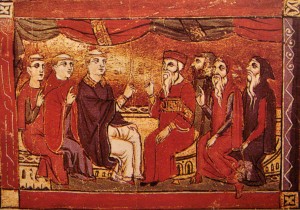In 1204, Norman, Venetian, and other European forces heeded the call of Pope Innocent III for a Fourth Crusade to take back the Holy Land from the Muslim conquerors. In a bizarre chain of events brought on primarily by a lack of funds, a deal with an ousted prince of Constantinople, and a fair smattering of greed, most of the Crusaders never made it to the Holy Land, but instead captured the city of Constantinople and large portions of territory of the Roman Empire – including the islands of the Mediterranean. An earlier agreement amongst the Nobles stipulated how the wealth and the lands were to be divided among the Crusader Nobility. They enthroned one of their own as a new Byzantine Emperor and a Roman Catholic cleric as the new Patriarch of Constantinople The Orthodox Christians were to surrender their heretical ways and recognize the Pope of Rome as their head and to become good Latin Christians subject to new Latin bishops and priests.[i] (The occupation lasted less than sixty years until forces of the Empire recaptured Constantinople and took back the thrones of the Eastern Roman Empire and the Eastern Orthodox Patriarchy).
This proved, however, easier said than done. The Latin clergy met with resistance: sometimes with acts of violence from both sides, but often by simply ignoring the Latin clergy and continuing to give preference to their own Orthodox religious leaders. Especially in the outer regions of the new empire and the Mediterranean islands of Cyprus and Crete, the Latin clergy found it easier to be accommodating and “look the other way” as long as they could still be nominally in charge. In their areas of control, the Venetian leadership (primarily the sea ports and the islands) fostered a great deal of leniency between the Orthodox Christians and the large contingent of Venetian colonists – the Venetians tended to be more loyal to their trade interests than to the Latin Pope.
During the period following the sack of Constantinople and continuing up to pre-modern times, there occurred an interesting development (especially in the island regions). The Christian populations (laity and clergy) realized that neither was going to go away or be completely absorbed by the other. Facing that reality and not wanting to live in constant turmoil, they developed a plan. We do not know how it came into being or what locality was first, but there is evidence that some churches shared a building for both Latin and Orthodox services. “In many Greek islands there were also mixed churches, with parallel naves and two adjacent sanctuaries, one for the Greek, and the other for the Latin rite.”[ii] While an Orthodox congregation was celebrating the Divine Liturgy in one sanctuary, a Latin congregation the Latin Rite Liturgy on the other side of the same building (combined coffee hour afterwards?).
What has this to do with the modern Orthodox Church in America? I think the example presented by the churches in the Mediterranean islands provide us with an interesting solution for the Pan-Orthodox Church in America, but does not necessarily include merging with the Church of Rome (which would be wonderful, but after 1,500 years it’s not likely and we should get over it and move on).
Here’s the thing: Old World Orthodox parishes in America are dwindling. There are some old, rather large edifices that are now underused and expensive to maintain. There are many parishes with very small populations (old neighborhood cultures where the parishioners and/or their children long ago moved away. There are newer mission parishes that are struggling to get off the ground. At some point, there will be a culturally American designed group to attract the Christian converts and the kids of the Old World parishes. Many – if not most – of these parishes are having difficulty paying their priests what they deserve, maintaining the facilities, and keeping up with a cycle of services.
The reality is: Most Orthodox Christians want to unite. However, some do not want to give up the cultural based services they have grown up with (perhaps in the language they grew up with), nor should they. Also, more protestants are becoming interested in the Orthodox Church but are not interested in the Old World cultures (as wonderful as they are) – and not especially attracted to the Western Rite (as wonderful as that is).
Solutions: While we wait for the hierarchs (both Old World & New) to develop a plan for unity in the American Orthodox Church, there can be a Pan-Orthodox plan to merge parishes and have multiple services in a shared facility.
- Multiple Jurisdictions
- Greeks sharing with Antiochian
- Serbians with OCA
- Even three culturally different parishes sharing a common facility
- Eastern Rite with Western Rite
- Old World along with a new American Rite parish
- A campus where one or more jurisdictions/flavors of Christian Orthodoxy can share the land costs and have multiple sanctuaries (perhaps sharing a parish hall and classroom space).
Shared Operations:
- Combine the Parish Councils or create an oversight committee
- Share the expenses where possible
- Meet together for a shared coffee hour
- Share the Vespers duties
- Work together for the Past, Present, and Future Orthodox Church.
For a Eucharist to be valid do the Jurisdictions have to be separated by so many miles, or blocks, or feet, or patches of grass? Can’t they merely be separated by a wall or an upper/lower level of the same building?
The obstacles are not ecclesiastical. They are “people” obstacles. Overcoming the obstacles will require people talking to each other, trusting each other, and working to overcome any issues (who owns what?; who pays for what?; who is responsible for what?). These “people” include parishioners, Priests, Bishops, and Primates – the Body of Christ.
We must work together now to ensure that there is an Orthodox Christian presence in America beyond the next 50 to 100 years.
______________________________________________
[i] Phillips, Jonathan, The Fourth Crusade and the Sack of Constantinople, (New York: Viking Penguin, 2004).
[ii] Ware, K. T. Orthodox and Catholics in the Seventeenth Century: Schism or Intercommunion?, in Schism Heresy and Religious Protest, Vol. 9 of Studies In Church History, ed. Derek Baker (Cambridge: Cambridge U. P., 1972, 263. See also: Hussey, J. M., The Orthodox Church in the Byzantine Empire (Oxford: Clarendon Press, 1986), 205-206. Schabel, Christopher D., Greeks, Latins, and the Church in Early Frankish Cyprus, (Burlington, VT: Ashgate Publishing, 2010), 200-201. Stylianou, Andreas and Judith A. Stylinou, The Painted Churches of Cyprus, (Stourbridge, Worcestershire, England: Mark and Moody Ltd., 1964), 109.
Editor’s Note: Will the future of Orthodox Unity in the USA come about because dwindling church attendance within jurisdictional churches in the same area result in merges of parishes? It is happening. Johnson City, Tennessee is an example. GOA and Antiochian parishes have merged.
Roy Snyder is an Orthodox Christian Laity (OCL) Board Member and Secretary, a Life Member of the American Legion, and a Life Member and Secretary of the Sons of the American Revolution.





4 Comments
This type of merging especially campus one existed in my mind for a while. I also believe that some services like the Holy Week can be merged.
Now, would I support the One American Orthodox Church under a patriarch? Nope. But why, although a long time ago I used to be?
If the original Orthodox World was/is powerful, I would have supported it heavily, knowing that if America went wrong, others will stand up. Unfortunately, except for Russia, the rest are very week.
In today’s America, taking chances with having the most powerful Orthodox Church corrupt is The Destruction of Orthodoxy.
Today’s US is not the one our forefathers built. We are under the control of a very corrupt state that is willing to use everything for its own good. Which one is easier to control: One Church with many heads OR one church with One head!? Let’s face it: Papacy is everywhere, and everyone realizes it, including the CIA. But, in Orthodoxy, there is – till now – not one head to talk to.
Imagine we have our own patriarch, and the CIA sees it as a good opportunity to fight the Russians through Orthodoxy. A little bit of corruption (there is a lot of it), and the Church is in their pocket (lets not forget Athenagoros who was sent to Constantinople on board Air Force One for Patriarchate elections).
I am not saying that the Russian Church is maybe not in their own gov’s pocket. But the Russians are originally Orthodox, and even if they had an infiltration to destroy the Church, it will be very slow. Can we say the same about a country that can control the Church and is careless about God!?
Let’s face the truth: Churches dwell, because we don’t drag ourselves from our comfort to go to Church, because we allow our children to not go if they don’t want to, because we don’t want to contribute more of our time, because our priests and laity (I am first) pray less and less.
How many great ideas in the Church, especially ones that came from outside of the Church, ended up being destructive?
The world is controlled by very dark forces, not only spiritual forces, but from flesh and blood also.
There are a lot of Good voices that are seeking unity based on legit reasons, but there also those who are driving the bus, but toward a black hole.
We need to be extremely vigilant. We need to weigh again and again the risks. Our spiritual eyes are closed. It’s becoming worse and worse every day. What could happen if the One Church became corrupt? How much more Orthodoxy can we lose in this case?
The Vatican is an Amazing example.
That is the worst, paranoid excuse I’ve seen to date for not having ONE Orthodox Church on North American shores. Seriously?
My God, what a great writing on “unity” from Roy. I hope I get to know you soon, because I have really never seen “One Orthodox Church of America” written about so critically and succinctly. Someone said the people (laity) need to make this happen and until we get serious, it never will. We keep writing and writing about it but until we become active and verbal about it, it will never happen. We will lose friends, but hopefully we will make friends as well. We will not be destroying our ethnic roots, because they will always be a part of our foundation. I see Orthodox churches struggling all over our country, barely able to pay bills or attract more people. We are losing our youth to the chains of social media and anything but church. I see the obscenities in church management that show the weaknesses of men at its worst. If we Orthodox really aimed for salvation and utilized the essence of our Holy Faith, this would not happen. Let’s stop appearances of religious righteousness and exclusivity, and get down to basics with one Holy Catholic Orthodox Church of America.
I would urge your readers to read John P Burgess’ recent article in the recent issue of the Christian Century entitled, “The Unexpected Relationship Between U.S. Evangelicals and Russian Orthodox: Under Trump and Putin a Strange Alliance Gets Stronger.” The web address is listed below.
(The Russian Orthodox Church is the largest in number of adherents of the Byzantine, and or Greek, Orthodox Church. )
https://www.christiancentury.org/article/features/unexpected-relationship-between-us-evangelicals-and-russian-orthodoxhttps://www.christiancentury.org/article/features/unexpected-relationship-between-us-evangelicals-and-russian-orthodox